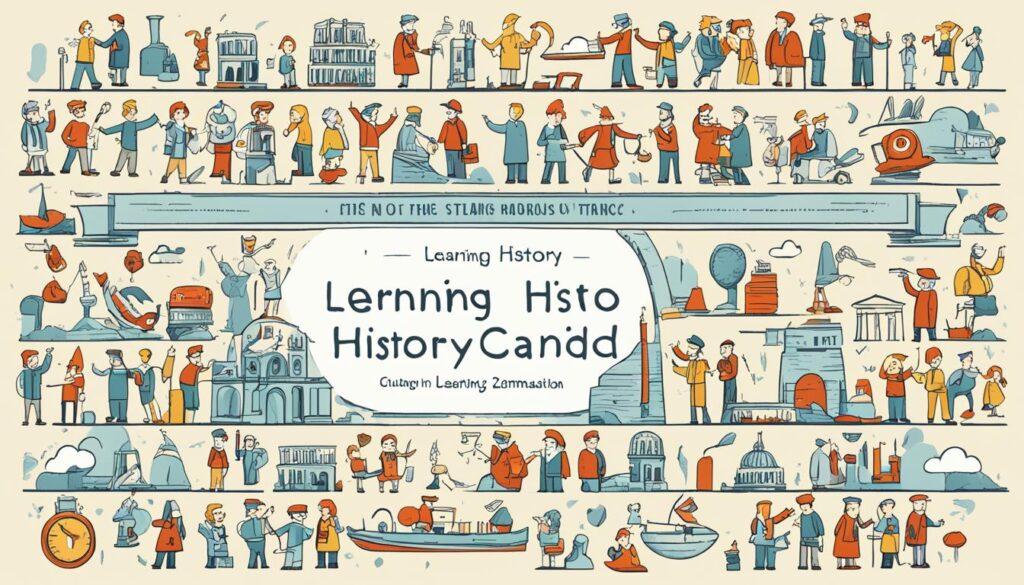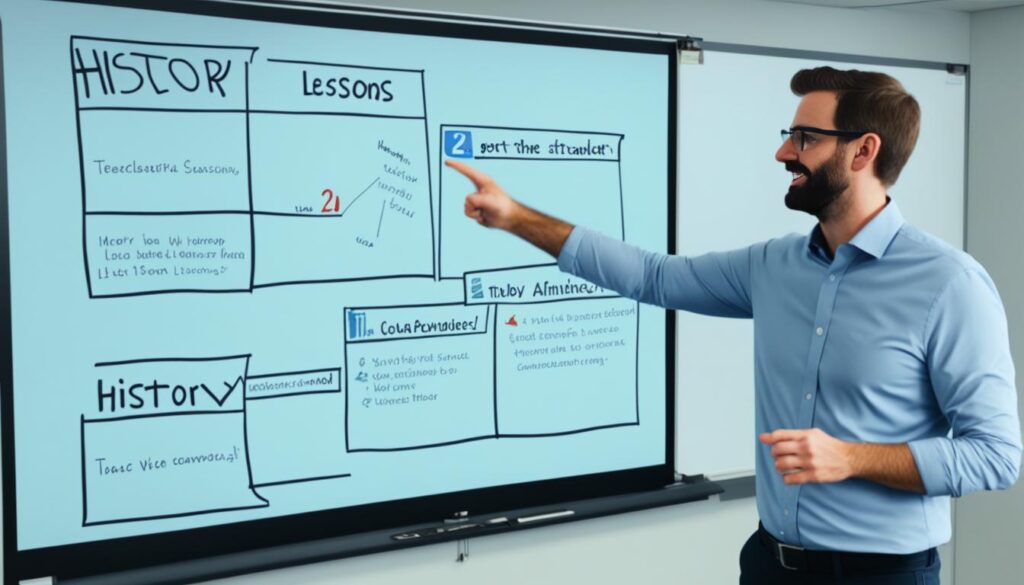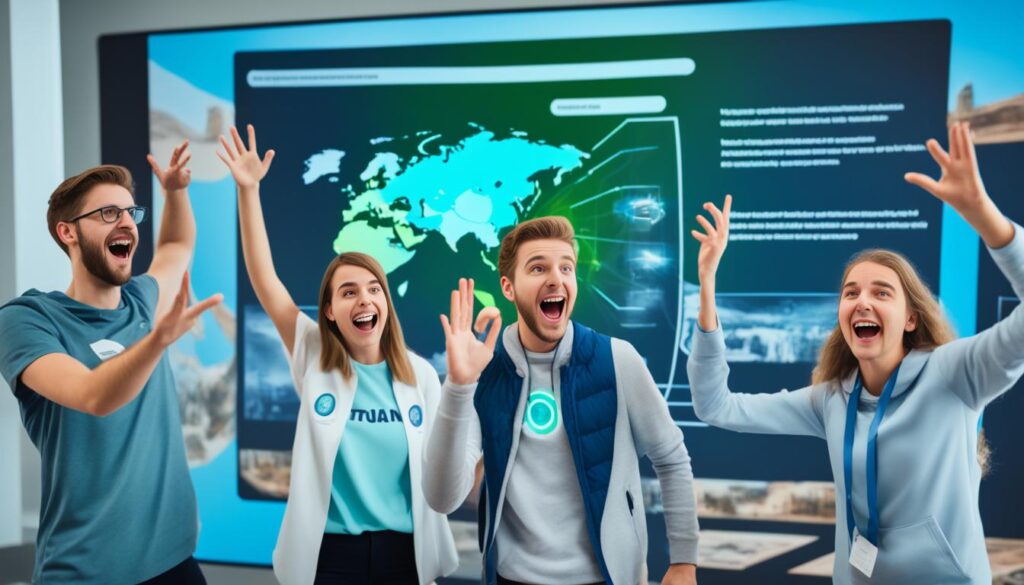In today’s world, students love visual media. Interactive 2D animation is changing the way we teach history. It makes learning fun and sticks in their minds.
With interactive 2D animation, students get to dive into history. They see and feel the past like they’re there. This makes learning fun and helps them remember what they learn.
Key Takeaways
- Interactive 2D animation brings history lessons to life, engaging students and enhancing their understanding of the past.
- Visual storytelling through animation captivates students, making learning more memorable and enjoyable.
- Leveraging the power of interactivity, students can actively participate in exploring historical events and narratives.
- The immersive nature of 2D animation fosters a deeper connection between students and the subject matter.
- Incorporating interactive 2D animation into history lessons can lead to improved knowledge retention and a more engaging learning experience.
The Power of Visualization in Education
Visual aids in education are very important. Many studies show how illustrations and animations help students learn and stay interested. These tools make hard topics easier to understand and remember by using the brain’s love for pictures.
How Visual Aids Enhance Learning
Visual aids make hard ideas simple and clear. They turn complex topics into something students can grasp easily. This is because the brain handles pictures and words differently, making learning more effective.
The Impact of Animation on Engagement
Adding animation to lessons changes how students feel about learning. Animation makes history come alive, making students more interested and connected. It uses fun and interactive 2D animations to keep students curious and excited, helping them remember more and love learning.
| Benefits of Visual Aids in Education | Impact of Animation on Learning |
|---|---|
|
|
Visualization is key in education. Using interactive 2D animations and other visual tools helps teachers reach their students fully. This creates a deep and engaging learning experience that sticks with students for a long time.
Interactive 2D Animation for History Lessons
Imagine a history lesson that takes students back in time. They can see key events happen and meet historical figures in a fun way. This is what interactive 2D animation does, making history come alive for young learners.
Interactive 2D animation makes learning history exciting. It grabs students’ attention and helps them understand the past better. By using this tool, teachers can make history stories come alive. Students get to explore and interact with the events that shaped our world.
Adding interactive 2D animation to history lessons has many benefits. It makes learning fun and engaging, making hard topics easier to remember. These animations also get students involved, helping them connect better with what they’re learning.
Interactive 2D animations can take students to different times. They let students see historical events happen right before their eyes. This helps them understand the context and reasons behind past events. It makes history more meaningful and interesting.
Teachers use interactive 2D animation to keep students interested in history. This method creates learning experiences that spark curiosity and encourage thinking. It helps students appreciate the depth and richness of human history.
Bringing Historical Events to Life
Interactive 2D animation lets educators take students right to the heart of history. It makes the past come alive and helps students understand its depth. This new way of teaching history makes it more engaging and meaningful.
Immersive Storytelling through Animation
Animated stories put students in the shoes of historical figures. They learn about their lives, struggles, and achievements. This immersive storytelling makes students feel connected and respect different experiences that shaped our world.
2D animation in history classes lets students join in on past events. They see key moments from different views. This helps them understand the past better, seeing the complexity of events and decisions.
“Animation has the power to transport us to different eras, allowing us to witness history through the eyes of those who lived it. This immersive experience fosters a deeper connection and appreciation for the past.”
As students go through these animated historical narratives, they learn to think critically. They ask questions, make observations, and come up with their own ideas. This active learning boosts their critical-thinking skills for school and life.
Interactive 2D animation makes history exciting and inspiring for students. It turns the past into a vibrant, engaging story. Students get to explore, discover, and appreciate the rich history of humanity.
The Benefits of Interactive Learning
Interactive learning, like using interactive 2D animations, changes how students engage with history. It makes learning more dynamic and fun. Students get to take part in their education, making it more immersive.
Interactive learning boosts student engagement. When students can touch and explore the content, they take charge of their learning. This makes them more invested in the subject, helping them remember more.
Interactive 2D animations let students dive into historical events. They get to understand the past better by interacting with it. This makes learning more real and meaningful.
“Interactive learning experiences have the power to transform the way students engage with and understand history. By placing students at the center of the learning process, we unlock a new level of enthusiasm and knowledge retention.”
Interactive learning does more than just improve understanding. It also makes students more interested in the subject. When students are part of the learning, they start to love the topic. This leads to a lifelong love of learning.

Interactive learning changes history lessons for the better. It grabs students’ attention and encourages them to explore the past. Using tools like interactive 2D animations makes history come alive for students.
Designing Engaging 2D Animations
Creating engaging 2D animations for history lessons means knowing how to tell stories with visuals. Teachers need to think about several important things to make their lessons fun and interesting for students.
Principles of Effective Animation
Good 2D animations use character design, color theory, and smooth movement. Teachers who get these basics can make animations that teach and grab their students’ attention.
- Character Design: Making characters that students can relate to is key. Teachers should think about what makes characters look real and interesting. This makes history come alive and helps students connect with it more.
- Color Palette: Colors can make people feel certain ways and set the mood of an animation. Teachers should pick colors that fit the time period and make the animation look good.
- Movement and Timing: Smooth movements and good timing make animations flow well. Teachers should know about animation basics like anticipation and staging. This helps make their animations engaging and keeps students watching.
Using these animation principles, teachers can make 2D visuals that teach and motivate students. This helps students understand and appreciate history more.
“Animation can explain whatever the mind of man can conceive. This facility makes it the most versatile and explicit means of communication yet devised for quick mass appreciation.”
– Walt Disney
Integrating 2D Animation into Lesson Plans
We know how powerful 2D animation can be in making learning fun for our students. Adding these animations to our history lessons can make a big difference. It’s all about planning how to use them well to keep students engaged and interested.
Strategies for Seamless Implementation
Here are some tips for adding 2D animation to your lessons:
- Align with Learning Objectives: Pick animations that help you meet your lesson goals. Make sure they help explain the important ideas you want to share.
- Enhance Storytelling: Use animation to make history come alive. This makes learning more fun and memorable for your students.
- Encourage Interactive Engagement: Add interactive parts to your animations, like clickable spots or choices. This gets students more involved and helps them learn more.
- Provide Context and Scaffolding: Fit the animations into your lessons smoothly. Add background information and support to help students understand and connect with the material.
- Monitor and Evaluate: Keep an eye on how the animations work. Ask students what they think and change things to make learning even better.
Using these tips, you can make 2D animation a key part of your history lessons. It lets students explore history in a fun and interactive way.

| Strategies | Benefits |
|---|---|
| Align with Learning Objectives | Ensures animations support specific educational goals |
| Enhance Storytelling | Brings historical events to life for a more immersive learning experience |
| Encourage Interactive Engagement | Promotes active learning and deeper understanding |
| Provide Context and Scaffolding | Helps students make meaningful connections and grasp the content |
| Monitor and Evaluate | Allows for continuous improvement and optimization of the learning experience |
Evaluating the Impact of 2D Animation
Teachers are looking into how 2D animations help in history classes. It’s important to see how these tools affect students’ learning. By looking closely at how well 2D animation works, we learn how it helps students understand, stay interested, and remember history better.
When we check how 2D animation affects students, we look at their learning results. We compare students who got lessons with 2D animations to those who didn’t. We use tests, essays, and projects to see if students know and use history better.
It’s also key to see how 2D animations make students more engaged. Surveys and focus groups tell us if the animations grab students’ attention and make them think more deeply about history. This helps teachers make sure the animations really connect with their students.
| Evaluation Metric | Description |
|---|---|
| Pre- and Post-Assessments | Measure student performance before and after the 2D animation-based lessons to gauge the impact on learning |
| Student Engagement Surveys | Gather feedback from students on their level of engagement, interest, and enjoyment of the 2D animations |
| Observational Data | Observe student behavior and interactions during the 2D animation-based lessons to assess engagement and participation |
| Project-based Evaluations | Assess students’ ability to apply the historical knowledge gained from the 2D animations in creative projects or problem-solving exercises |
By looking at how 2D animation affects students, teachers can make smart choices about using these tools in class. This careful look helps make sure 2D animations really improve learning and help students do better.
“The integration of 2D animations in history lessons has the potential to transform the way students engage with and retain historical information. By carefully evaluating the impact of these visual aids, we can unlock the true power of interactive learning.”
Resources and Tools for Educators
Getting the right tools is crucial for teachers to add interactive 2D animations to history lessons. This guide is for both experts and newcomers in educational tech. It introduces tools and platforms that make learning fun and engaging.
Recommended Software and Platforms
Check out a wide range of software and platforms designed for making 2D animations. There are free tools for beginners and paid ones with more features. These tools help make historical events come alive in the classroom.
- Powtoon: A cloud-based platform that makes animating easy for teachers. It helps create engaging 2D animations.
- Canva: Known for graphics, Canva also has an “Animate” feature. It’s great for making educational 2D animations.
- Adobe Animate CC: A top choice for professionals. It offers advanced tools for creating high-quality 2D animations.
- Vyond: Once GoAnimate, this platform is easy to use. It has many characters and templates to help start your animations.
These are just a few tools for teachers wanting to use 2D animations in history classes. Try different tools to see which fit your teaching style and student needs best.
“Interactive 2D animations in history lessons change how students learn complex events. These tools capture their attention, teach them, and inspire them to think deeply.”
Conclusion
Interactive 2D animation has changed how students learn about history. It uses visual aids and storytelling to make lessons fun and memorable. This new way of teaching has made history come alive for students.
The future looks bright for interactive 2D animation in education. Teachers who use this technology will grab their students’ attention. It helps students understand and appreciate history more deeply.
Teachers should check out the many resources and tools for adding interactive 2D animation to their classes. This method can start a new era of great learning. Students will become active learners, exploring the past like never before. Let’s work together to make history exciting for the next generation.
FAQ
What is the purpose of incorporating interactive 2D animation into history lessons?
Interactive 2D animation makes history lessons exciting and engaging. It helps students connect with the past in a new way. By using stories and visuals, teachers can make history come alive, making it easier to remember.
How can visual aids and animation enhance student learning in history?
Visual aids and animation make history easier to understand and remember. They use the brain’s love for visuals to simplify complex ideas. This makes learning fun and sticks in students’ minds.
What are the benefits of interactive learning experiences in history lessons?
Interactive learning experiences, like 2D animations, boost student interest and participation. They let students dive into the content, making history more meaningful. This approach helps students grasp the past’s complexities better.
What principles should be considered when designing effective 2D animations for history lessons?
When making 2D animations for history, focus on storytelling, character design, color, and movement. These elements should work together to draw students in and make history vivid.
How can educators seamlessly integrate 2D animations into their history lesson plans?
To add 2D animations smoothly to history lessons, pick the right ones that match your goals. Make sure they fit well with your teaching style to improve the learning experience for everyone.
How can the impact of using 2D animations in history lessons be evaluated?
It’s important to check how 2D animations affect history lessons. Look at how students learn, stay interested, and remember what they’ve learned. This helps see if the animations really help with understanding and remembering history.
What resources and tools are available for educators to create and integrate 2D animations into their history lessons?
Teachers have many tools and platforms to make and add 2D animations to history lessons. There are easy-to-use options, both free and paid, to help teachers use visuals to improve learning.
